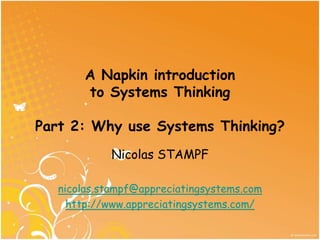Napkin Introduction to Systems Thinking - Why use ST?
•Descargar como PPTX, PDF•
0 recomendaciones•1,609 vistas
Denunciar
Compartir
Denunciar
Compartir

Recomendados
Recomendados
An approach to incentivize peer-reviewers in a trustworthy and transparent way. Rewards which people can actually spend, and, recognition for life.Recognition and reward system for peer-reviewers

Recognition and reward system for peer-reviewersKMI - Knowledge Media Institute, The Open University, UK.
Más contenido relacionado
Similar a Napkin Introduction to Systems Thinking - Why use ST?
An approach to incentivize peer-reviewers in a trustworthy and transparent way. Rewards which people can actually spend, and, recognition for life.Recognition and reward system for peer-reviewers

Recognition and reward system for peer-reviewersKMI - Knowledge Media Institute, The Open University, UK.
Similar a Napkin Introduction to Systems Thinking - Why use ST? (20)
Simulation in Social Sciences - Lecture 6 in Introduction to Computational S...

Simulation in Social Sciences - Lecture 6 in Introduction to Computational S...
Telegrams to Tweets: Delivering News at the Speed of Culture

Telegrams to Tweets: Delivering News at the Speed of Culture
Social Network Analysis Basics for Social Media Profs - Handout

Social Network Analysis Basics for Social Media Profs - Handout
Más de Nicolas Stampf
Más de Nicolas Stampf (16)
Some Workshop Agenda based on #liberatingstructures & #strength-based #change

Some Workshop Agenda based on #liberatingstructures & #strength-based #change
GTD Listes de déclenchement personelle et professionnelle

GTD Listes de déclenchement personelle et professionnelle
Strength based kanban - 2nd generation handout Lean Kanban France 2012

Strength based kanban - 2nd generation handout Lean Kanban France 2012
Strength-based Kanban (Lean Kanban France 2012 #lkfr12)

Strength-based Kanban (Lean Kanban France 2012 #lkfr12)
Napkin Introduction to Systems Thinking - Why use ST?
- 1. A Napkin introduction to Systems Thinking Part 2: Why use Systems Thinking? Nicolas STAMPF nicolas.stampf@appreciatingsystems.com http://www.appreciatingsystems.com/
- 2. Agenda • Part 1. What is Systems Thinking? • Part 2. Why use Systems Thinking? • Part 3. How to do Systems Thinking?
- 3. Why: a simple answer Using ST allows you to inquire what’s behind the obvious
- 4. Why: an elaborated answer Using ST allows you to inquire into the details as well as the environment the system belongs to
- 5. Better quality of your mental models
- 6. Allows you to test your systemic hypothesis By modelling and creating Behavior over Time graphs
- 7. Use for your own understanding…
- 8. … or connect with that of others
- 9. Next… • Part 1. What is Systems Thinking? • Part 2. Why use Systems Thinking? • Part 3. How to do Systems Thinking?
- 10. Credits • Gene Bellinger – @systemswiki – http://www.systemswiki.org/ • Members of Systems Thinking World LinkedIn Group – http://is.gd/lxLc9w • Dan Roam – @dan_roam – http://www.napkinacademy.com • Moleskine® – http://www.moleskine.com/
